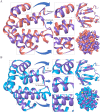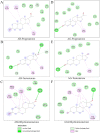Another cat and mouse game: Deciphering the evolution of the SCGB superfamily and exploring the molecular similarity of major cat allergen Fel d 1 and mouse ABP using computational approaches
- PMID: 29771985
- PMCID: PMC5957422
- DOI: 10.1371/journal.pone.0197618
Another cat and mouse game: Deciphering the evolution of the SCGB superfamily and exploring the molecular similarity of major cat allergen Fel d 1 and mouse ABP using computational approaches
Abstract
The mammalian secretoglobin (SCGB) superfamily contains functionally diverse members, among which the major cat allergen Fel d 1 and mouse salivary androgen-binding protein (ABP) display similar subunits. We searched for molecular similarities between Fel d 1 and ABP to examine the possibility that they play similar roles. We aimed to i) cluster the evolutionary relationships of the SCGB superfamily; ii) identify divergence patterns, structural overlap, and protein-protein docking between Fel d 1 and ABP dimers; and iii) explore the residual interaction between ABP dimers and steroid binding in chemical communication using computational approaches. We also report that the evolutionary tree of the SCGB superfamily comprises seven unique palm-like clusters, showing the evolutionary pattern and divergence time tree of Fel d 1 with 28 ABP paralogs. Three ABP subunits (A27, BG27, and BG26) share phylogenetic relationships with Fel d 1 chains. The Fel d 1 and ABP subunits show similarities in terms of sequence conservation, identical motifs and binding site clefts. Topologically equivalent positions were visualized through superimposition of ABP A27:BG27 (AB) and ABP A27:BG26 (AG) dimers on a heterodimeric Fel d 1 model. In docking, Fel d 1-ABP dimers exhibit the maximum surface binding ability of AG compared with that of AB dimers and the several polar interactions between ABP dimers with steroids. Hence, cat Fel d 1 is an ABP-like molecule in which monomeric chains 1 and 2 are the equivalent of the ABPA and ABPBG monomers, respectively. These findings suggest that the biological and molecular function of Fel d 1 is similar to that of ABP in chemical communication, possibly via pheromone and/or steroid binding.
Conflict of interest statement
The authors have declared that no competing interests exist.
Figures









Similar articles
-
The mouse salivary androgen-binding protein (ABP) alpha subunit closely resembles chain 1 of the cat allergen Fel dI.Biochem Genet. 1994 Aug;32(7-8):271-7. doi: 10.1007/BF00555830. Biochem Genet. 1994. PMID: 7826314
-
Characterization of two forms of mouse salivary androgen-binding protein (ABP): implications for evolutionary relationships and ligand-binding function.Biochemistry. 2003 Jun 17;42(23):7162-70. doi: 10.1021/bi027424l. Biochemistry. 2003. PMID: 12795612
-
Structural characterization of the tetrameric form of the major cat allergen Fel d 1.J Mol Biol. 2007 Jul 20;370(4):714-27. doi: 10.1016/j.jmb.2007.04.074. Epub 2007 May 10. J Mol Biol. 2007. PMID: 17543334
-
Update of the human secretoglobin (SCGB) gene superfamily and an example of 'evolutionary bloom' of androgen-binding protein genes within the mouse Scgb gene superfamily.Hum Genomics. 2011 Oct;5(6):691-702. doi: 10.1186/1479-7364-5-6-691. Hum Genomics. 2011. PMID: 22155607 Free PMC article. Review.
-
The major cat allergen, Fel d 1, in diagnosis and therapy.Int Arch Allergy Immunol. 2010;151(4):265-74. doi: 10.1159/000250435. Epub 2009 Oct 22. Int Arch Allergy Immunol. 2010. PMID: 19844127 Review.
Cited by
-
Mammalian derived lipocalin and secretoglobin respiratory allergens strongly bind ligands with potentially immune modulating properties.Front Allergy. 2022 Aug 4;3:958711. doi: 10.3389/falgy.2022.958711. eCollection 2022. Front Allergy. 2022. PMID: 35991307 Free PMC article.
-
Human allergy to cats: A review for veterinarians on prevalence, causes, symptoms and control.J Feline Med Surg. 2022 Jan;24(1):31-42. doi: 10.1177/1098612X211036793. Epub 2021 Oct 8. J Feline Med Surg. 2022. PMID: 34622710 Free PMC article. Review.
-
Keep the cat, change the care pathway: A transformational approach to managing Fel d 1, the major cat allergen.Allergy. 2019 Oct;74 Suppl 107(Suppl 107):5-17. doi: 10.1111/all.14013. Allergy. 2019. PMID: 31498459 Free PMC article.
-
New Frontiers: Precise Editing of Allergen Genes Using CRISPR.Front Allergy. 2022 Jan 17;2:821107. doi: 10.3389/falgy.2021.821107. eCollection 2021. Front Allergy. 2022. PMID: 35386981 Free PMC article. Review.
-
Impact of Semiochemicals Binding to Fel d 1 on Its 3D Conformation and Predicted B-Cell Epitopes Using Computational Approaches.Int J Mol Sci. 2023 Jul 20;24(14):11685. doi: 10.3390/ijms241411685. Int J Mol Sci. 2023. PMID: 37511444 Free PMC article.
References
-
- Mukherjee AB, Chilton BS. The uteroglobin/Clara cell protein family. Ann N Y Acad Sci. 2000;923: 1–356. - PubMed
-
- Daniel JC. Discovery and perspectives from the blastokinin era. Ann N Y Acad Sci. 2000;923: 1–8. doi: 10.1111/j.1749-6632.2000.tb05515.x . - DOI - PubMed
-
- Beier HM. The discovery of uteroglobin and its significance for reproductive biology and endocrinology. Ann N Y Acad Sci. 2000;923: 9–24. doi: 10.1111/j.1749-6632.2000.tb05516.x . - DOI - PubMed
-
- Niimi T, Keck-Waggoner CL, Popescu NC, Zhou Y, Levitt RC, Kimura S. UGRP1, a uteroglobin/Clara cell secretory protein-related protein, is a novel lung-enriched downstream target gene for the T/EBP/NKX2.1 homeodomain transcription factor. Mol Endocrinol. 2001;15: 2021–2036. doi: 10.1210/mend.15.11.0728 . - DOI - PubMed
-
- Watson MA, Fleming TP. Mammaglobin, a mammary-specific member of the uteroglobin gene family, is overexpressed in human breast cancer. Cancer Res. 1996;56: 860–865. . - PubMed
Publication types
MeSH terms
Substances
Associated data
LinkOut - more resources
Full Text Sources
Other Literature Sources
Molecular Biology Databases
Miscellaneous

